
Front view, Titanic Belfast. CivicArts / Eric R. Kuhne & Associates & London Todd Architects, Belfast
Due to the large volumes of visitors they only let in groups of people every 20 minutes. You wait in the queue at the bottom of the escalators. It became obvious that most visitors went in groups, I was one of the few individual visitors. Its very much a day out for families, tourists, and schoolgroups. The building is buzzing with all the activity of the exhibition on the upper floors, and the Galley restaurant and shop on the ground floor. The ground floor itself is a bit of organised chaos, a bit confusing when you first enter the building.
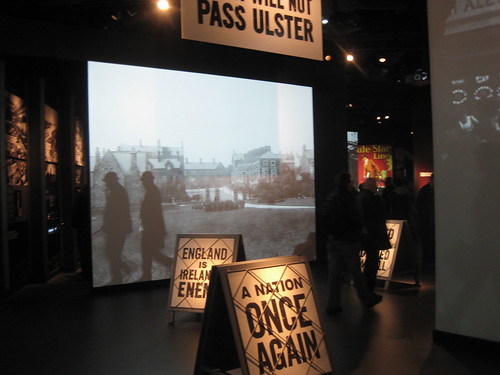
'Boomtown Belfast'
The first stage of the exhibition, aims to set the scene, or context of the period in which the RMS Titanic set sail. It was a politically potent time in Northern Ireland (as the sandwich boards and banners reflect). These were the years before the Republic of Ireland attained its sovereignty from Britain.
Large screens display archive footage of the streets of Belfast, whilst silhouettes in period clothing walk vertically across the screen every now and them, coupled with the noise of the archive city to recreate the experience of the city. Personally I felt like it added another distraction to a room already filled with people and interactive exhibits.
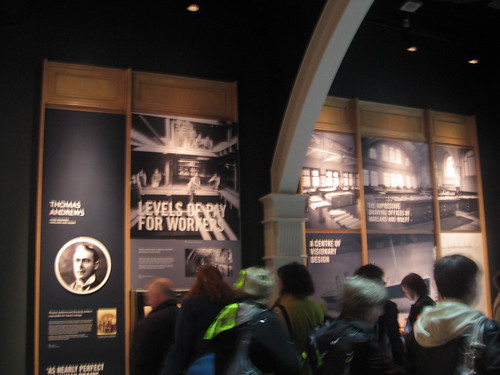
We are given a run through of life in Belfast at the time, Belfast as "Linenopolis". Linen was a particularly strong industry in Northern Ireland throughout the 18th and 19th centuries, until the turn of the century. Belfast had a strong shipbuilding heritage, like Glasgow, Liverpool and Southampton. RMS Titanic was constructed in the iconic Harland and Wolff shipyard. Titanic Belfast is built on part of the site occupied by Harland and Wolff's shipyard.
Initially I enjoyed how the exhibits explored the social and economic background of Belfast and the Harland and Wolff workers, from the dockers to the office men. Unfortunately, I found in the absence of artefacts, a lot of interactive screens were cluttered around the gallery to make up for this lack of primary sources (a common theme throughout the exhibition itself). They were noisy, and for me, ultimately unengaging, I would have preferred to have looked at contemporary artefacts instead of playing around on a computer screen, or playing an interactive game.
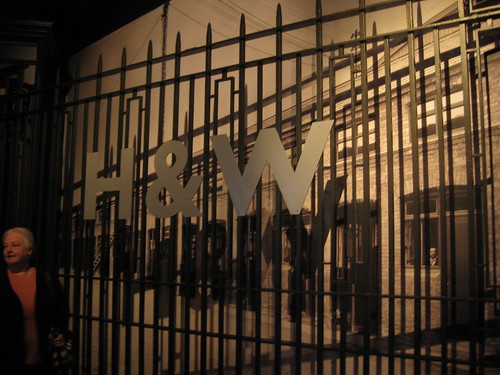
The building work records that original Harland and Woolf gates were installed as part of Titanic Belfast's construction, I'm not entirely sure if these were them, as they are quite a focal point.
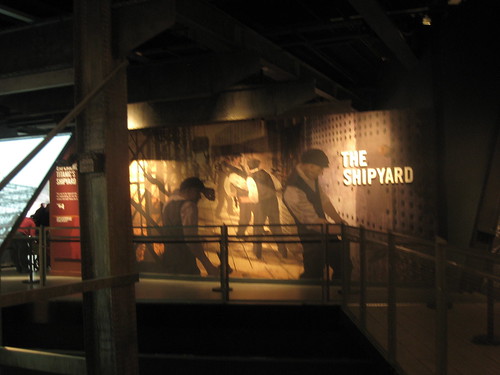
As I progressed further, a bizarre turn of events took place, unlike anything I've seen or expected from a museum. I joined a lengthly queue to wait on a Shipyard Ride. The ride was an audio and visual guide as it took you on a tour of a recreated shipyard, informing you how a ship was made, what sort of materials were used, how much manpower would have gone into the construction of the RMS Titanic. It was a bit of a novelty and I suppose if it had been composed as a standard "What was the Shipyard like?" exhibit it wouldn't have been as engaging. I really don't think that it added anything to the experience for me, I would rather have progressed through the exhibition at my own pace and not spent ten minutes queuing for ride that I couldn't just skip past. It was a novelty, but it is a concept that could potentially date very rapidly, five, or ten years down the line.
'The Launch' gallery was exciting - I loved the frosted glass that looks out upon the original launch site. I don't have any pictures sadly, but I thought this gallery was a lovely addition to the flow of the museum. It lent a brief moment of contemplation to the visitor as you progress through the museum.
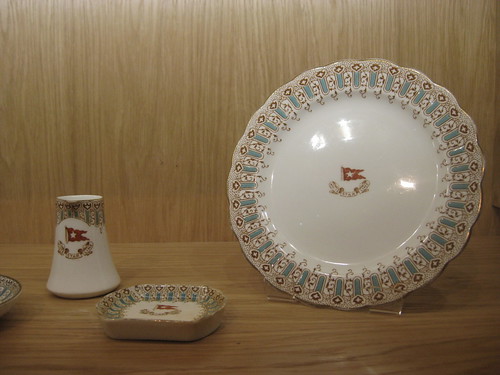
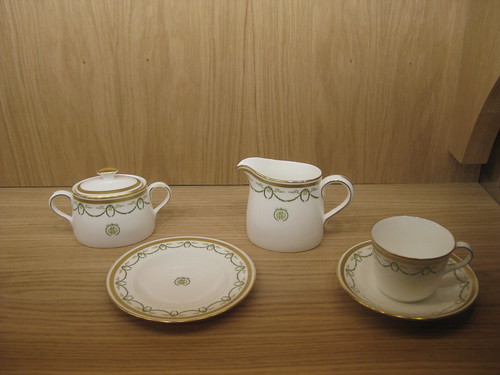
Original White Star Line first class crockery, from RMS Titanic, originally made by The Royal Crown Derby Porcelain Company
'The Fit Out' gallery was the one I was most looking forward to, owing to my own interest in interiors. This gallery recreated three bedrooms, for first, second and third class passengers on the Titanic. These were contained behind glass, and included video projections of people in the costume of the period, according to class. One of the shortcomings of relying too heavily on interactive exhibits was glaringly in evidence here, at least two of the projections were not working while I was there. I think displaying the costumes of the time alongside the room refits would have been more effective, and significantly less hassle. I don't especially need to see a projection of someone in character brushing their hair to help me understand what someone does in their cabin.
This room had a small amount of artefacts, it also had a walkthrough of the styles used in the interiors, and particularly the dining rooms of the the Titanic, comparing it to other luxury liners of its time. Titanic's interiors were far superior to cruise liners of the period, particularly for second and third class passengers. Obviously, displaying genuine artefacts here is an issue, considering most of them are buried 4km below the Atlantic ocean. It was more how they were displayed that I had issue with, but overall, save for the room refits, I felt this gallery was laid out appropriately.

I was particularly piqued by this recognition of Ireland's Titanic town. Mary Mangan was one of 14 passengers from a small community in County Mayo, in the Republic of Ireland. Addergoole Parish (Lagardane) is so-called 'Ireland's Titanic town' as this community suffered the most loss of life in the tragedy, proportionate to its population. Eleven of the fourteen passengers from Addergoole died when RMS Titanic sank on her maiden voyage.
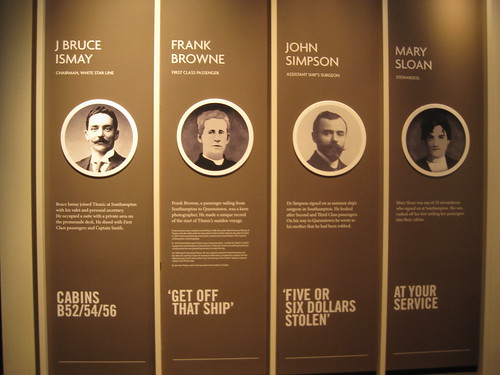
These personal vignettes give the passengers motives for being on the Titanic, some are more poignant than others, such as "Home to show off the ring".
The Maiden Voyage
This is where things started to get personal. For me, this was the most effective element of the whole exhibition. It features the personal stories of the passengers and crew, and their motives for sailing on RMS Titanic. Individual stories were highlighted according to where the passenger docked. On its maiden voyage RMS Titanic had four stop off points on its journey: Belfast, Southampton, Cherbourg and Cobh (then known as Queenstown).

Father Browne's iconic photographs were used to maintain the link between the previous exhibit as one went down the stairs to The Sinking gallery.

The whole architecture of the building itself was very angular, one could look over railings to the floors below, and the large domineering windows that looked out onto the harbour gave one the illusion of being on a deck.
Four more galleries followed after this which I will sum up briefly as I have no visual guides (I didn't take pictures to be honest). The Sinking is an interactive exhibit, with icy cold air conditioning recreating the atmosphere on the Atlantic on that faithful night, with morse code signals ringing in our ears. This seemed fairly effective as my fellow passengers, nay, visitors got quite emotional throughout the course of this. Interactive screens profiled individual passengers and rescue stories.
The heroism and horror of Titanic’s final hours are induced with atmospheric sound and lighting to create a subtle and moving evocation of the ship’s catastrophic and untimely demise.
The Aftermath - This exhibit details the trials that took place on both sides of Atlantic after the sinking of the Titanic. It also highlights the recommendations that influenced major changes in maritime regulations to enforce new safety measures, such as ensuring that more lifeboats were provided. Some of the American trial is reacted in a visual exhibit, something we have already established that Titanic Belfast is preoccupied with.
Myths and Legends brings together the many stories, media reports, legends and fantasies that have grown up around the Titanic story. Displays of Titanic memorabilia (from the tame to the tasteless: Titanic ice cube tray anyone?), clips from movies and musicals (Celine Dion on a 5 minute loop really) form the basis of this exhibit. It gives you an opportunity to giggle at the recognise iconography and myth that has grown up around the Titanic myth.
One of the most compelling exhibits Visit & Explore the Wreck gave the visitor access to Dr. Ballard’s high-definition footage from the wreckage. Ballard and his team discovered the wreck of the Titanic in 1985, 4km below sea level. For me, absorbed as I was within the theatre that this footage was being played, the concept was a little marred by a clunky, scripted narrative by two actors who made subjective comments on selected items of debris around the ship (shoes, crockery, etc).
The final exhibit, the Ocean Exploration Centre was made up of... interactive exhibits! You can never have enough, or can you? While not directly linked to the Titanic the aim of this exhibit is to explore what makes up our oceans and aims to provide up to date information on marine biology and archaeology. There was some interesting information panels but ultimately it didn't hold much of my interest so I made a quick exit. I have no doubt that it would interest some people but for me it felt anticlimatic as an end to the "Titanic experience".

One of the Samson and Goliath shipbuilding cranes. These two twin cranes are still in use today and their imposing presence in the harbour around Titanic Belfast allude to the city's shipbuilding history.
Titanic Belfast is ambitious in its vision, I'm not certain if it hasn't isolated part of its market by being just too interactive, at the cost of a real human connection with the objects and the story. Everything is new and glossy, but what will happen when the initial crowds reduce in the coming years. It will be interesting to see how the surrounding Titanic Quarter develops as a cultural hub for Belfast and beyond.


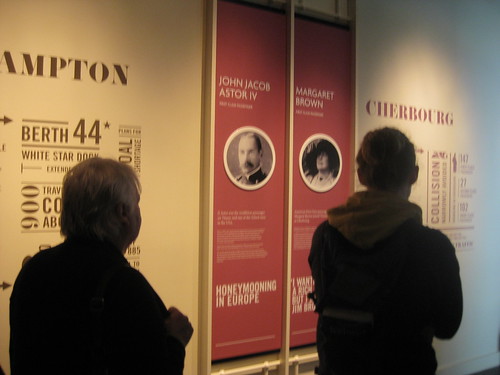
I am so disappointed that there aren't more exhibits!! And don't even get me STARTED on the "corporate" staircase. What BS!!
ReplyDelete(From what I've seen) The layout of the building is nice, definitely got that ship-feel to it. But with the sizeable crowds, I feel that interactive exhibits aren't the best way to go. People want to be entertained and EDUCATED in museums. I think that the Titanic Museum seems guilty of dumbing everything down and of course, raising prices!
Maeve I am so glad you agree!! Titanic Belfast didn't retweet this because they don't want to hear the negative I expect, but it IS expensive. If I wanted to interact with everything I could have stayed at home and clicked around on their website and gotten the general idea, for free! I paid £9.50 for a student ticket.
DeleteAnd yes, I should have put that in - with the volume of people visiting, jostling to look at a computer screen isn't the kind of museum experience I would expect, or want to engage in. Its very one dimensional really. It was only until I got to the passenger profiles did I begin to feel a real human engagement with the Titanic story and I really wish they could have expanded on that.
Exactly! Maybe I'm biased, having worked in the Ulster American Folk Park, but to me, that's what a museum should be like. If the govt are going to plunge £££ into museums, they should be educational instead of robotic. At the UAFP you walk through 1800s Ireland. You can touch the houses, materials, smell and see! The "guides" answer questions from the most primary to the more historically-minded. You can board the famine-esque ship and arriving in the New World gives such a sense of the entire experience.
DeleteTo me, that is interaction. Not standing queuing for a ride or pressing buttons on a machine. You want to see Titanic artefacts, you want to be able to see, smell and touch types of materials. The Titanic Belfast could easily have made an example home of a shipbuilder, for example. In actuality they could have just made a REPLICA SHIP and allowed everyone to wander around with those little headsets. A "beforehand" and "aftermath" gallery with information written by a historian would have been fine.
I really do think the whole thing is an exercise in commercialisation. When I was in the foyer a few weeks ago, there was a queue to get into the shop. The tiny cafe was overrun and honestly, I'm not chomping at the bit to go back, pay £14 to stand in line and at the end of the day not even get a fun Jack and Rose-alike photo taken in the stairwell because I'm not "corporate". Grrr! :)
The dining room for the first class was located on the Deck D
ReplyDelete